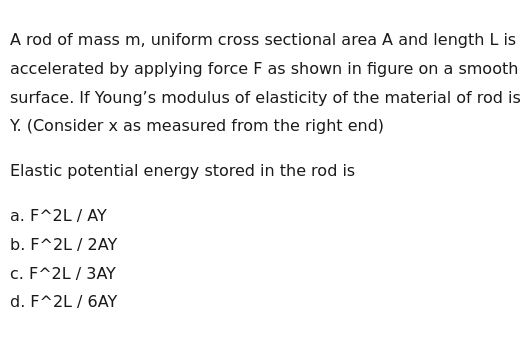Question
Question: A rod of mass m, uniform cross sectional area A and length L is accelerated by applying force F as s...
A rod of mass m, uniform cross sectional area A and length L is accelerated by applying force F as shown in figure on a smooth surface. If Young’s modulus of elasticity of the material of rod is Y. (Consider x as measured from the right end)
Elastic potential energy stored in the rod is

F^2L / AY
F^2L / 2AY
F^2L / 3AY
F^2L / 6AY
F^2L / 6AY
Solution
Solution:
- Find the tension distribution
Consider an element of the rod from a point x (measured from the right end) to the left end. The mass of this segment is
dm=Lm(L−x).Since the entire rod is accelerating with acceleration a=mF (because the force F is only applied at one end), the force needed to accelerate the segment is
dF=dm⋅a=mF⋅Lm(L−x)=LF(L−x).Thus, the internal tension at the section located at x is
T(x)=LF(L−x).- Determine strain and elastic energy density
The strain at x is given by Hooke’s law as
ϵ(x)=AYT(x)=AYLF(L−x).The elastic energy density (energy per unit volume) in the rod is
u(x)=21Yϵ(x)2.- Integrate to find the total elastic potential energy (U)
The total energy stored in the rod is obtained by integrating the energy density over the entire volume of the rod:
U=∫0Lu(x)Adx=21YA∫0L(AYLF(L−x))2dx.Simplify the integrand:
(AYLF(L−x))2=A2Y2L2F2(L−x)2.Thus,
U=21YA⋅A2Y2L2F2∫0L(L−x)2dx=2AYL2F2∫0L(L−x)2dx.Evaluate the integral by letting u=L−x; when x=0, u=L and when x=L, u=0. Then,
∫0L(L−x)2dx=∫0Lu2du=3L3.Therefore,
U=2AYL2F2⋅3L3=6AYF2L.Final Answer:
The elastic potential energy stored in the rod is
6AYF2L.